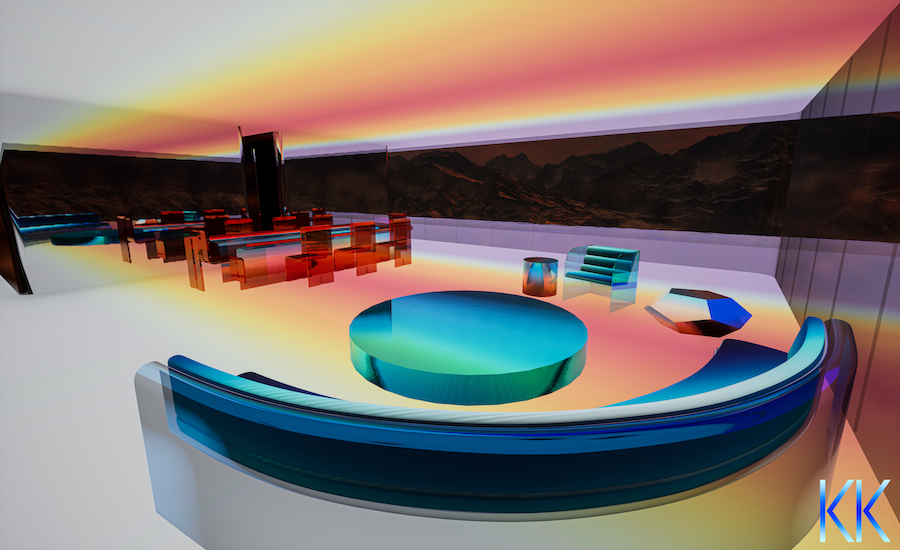You’ve probably heard of NFTs – it’s all over the internet. If you’ve missed this recent addition to the cryptocurrency boom, NFTs is an acronym for non-fungible tokens. They are a form of digital data that is accessible for purchase on the blockchain and may be minted, purchased, and sold with cryptocurrency.
 An NFT depicting architect in an imaginary world | @archdaily
An NFT depicting architect in an imaginary world | @archdaily
What is an NFT?
NFTs are concerned with how ownership of a specific unique (i.e. non-fungible) asset is validated using a smart contract. Smart contracts record NFT transactions on the blockchain, a digital ledger that powers the trade of cryptocurrencies such as Bitcoin and Ether, using a process known as mining.
The creator of an NFT can set not just the selling price, but also any additional terms such as royalties or a commission when it is resold. As a result, the creator may be able to generate a long-term source of income.
The primary advantage of NFTs is that they are permanent, which means that information on the blockchain cannot be readily modified or changed. Furthermore, because digital assets are non-fungible, they cannot be copied in the same way that other crypto assets such as Bitcoin can.
The rise of NFTs A digitally created landscape | @designwanted
A digitally created landscape | @designwanted
SofA, a platform founded in Melbourne, employs NFTs to transform projects into digitally and physically unique sources that can then be sold for long-term profit. The concept aims to address the escalating expenses of working with architects, which are increasingly out of reach for the average person or community.
By transforming design into tokenized and investable assets, SofA enables emerging and experienced creators to share their production costs among limited series and collect royalty payments in perpetuity for good design. As a new wave of digital architecture arises, it is impossible to deny that it offers up a virtual universe of possibilities.
NFTs and architecture
 Krista Kim's NFT house | @architecturalrecord
Krista Kim's NFT house | @architecturalrecord
NFTs allow for unique architectural designs to be created that may be sold by the inventor and certified on a blockchain issued by anyone. Furthermore, most NFTs have a Metadata tag that may be changed to provide details such as the creation date, artist name, and past owners.
NFTs have also fueled a new interest in virtual worlds, where users can gain access to items that do not exist. 3D artist Krista Kim, for example, recently auctioned off a virtual house. The NFT sold for over $500,000 and piqued collectors' interest.
Obstacles The road to a digitalized world is not an easy one | @geekflare
The road to a digitalized world is not an easy one | @geekflare
Despite the fact that the NFT train is going, others say it is a bubble that will eventually burst. This is due to a lack of price restriction and the existing mindset of purchasing NFTs for resale for profit in the future.
NFTs also highlights the issue of ownership, because digital images are typically not held by a single person, but rather by a design firm in the architecture business. This could result in a conflict of interest over who benefits from NFTs.
Regardless, NFTs offer a novel concept that may require a rethinking of how architecture and design work in the future. Furthermore, it enables smaller design firms to tap into an altogether new market and source of revenue.
It is well known that architecture is a difficult profession, and potential architects can use NFTs to take their creativity to the next level. They will also be able to commercialize their creations without the limits of project fees, excessive transaction costs, and other issues. The acceptance of NFTs by popular artists is also encouraging for the burgeoning business.
With everything from memes to tweets and digital scents being produced, there are signs of NFT weariness as the number of transactions and average price have begun to decline.
Another big issue with NFTs is their environmental impact, with architects canceling forthcoming releases after learning about the accompanying carbon emissions.
The Ethereum blockchain is used by the majority of NFT marketplaces, which means that when an NFT is minted and sold, all of the computers in Ethereum's network race to validate the transaction using a proof of work (PoW) mechanism. This process requires a lot of energy.
What’s next?
 SofA is the world's first blockchain design community | @yellowtrace
SofA is the world's first blockchain design community | @yellowtrace
Because sellers are not required to own a digital asset in order to manufacture a token for it, a number of ownership conflicts have occurred in recent weeks, with a number of artists whose works were sold without their consent.
However, NFT marketplaces will soon begin to implement many tiers of security, including identity verification, in the coming months to address these vulnerabilities.
With these changes, some designers, too, believe that these are simply the growing pains of a new market.










